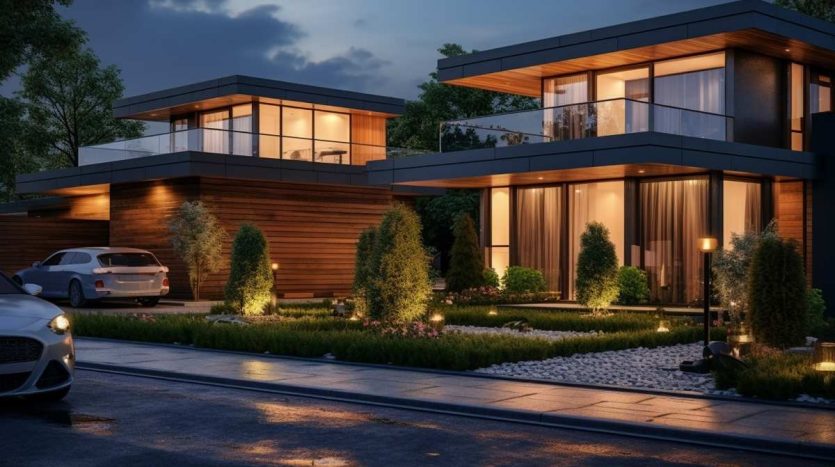Smart Homes 2025: Transforming Everyday Living
Introduction
In 2025, the way we live, interact, and manage our homes has undergone a remarkable transformation. The integration of artificial intelligence (AI), the Internet of Things (IoT), and sustainable technologies has revolutionized modern living. Smart Homes 2025 are no longer a futuristic vision, they are our new reality, redefining convenience, efficiency, and connectivity. For homeowners, investors, and anyone interested in buying a home, understanding this transformation is essential. Beyond improving lifestyle comfort, smart home technology is changing the real estate landscape, influencing property values, buyer expectations, and even neighbourhood development. Let’s explore how Smart Homes 2025 are transforming everyday living, and what this means for the future of homeownership.
The Rise of Smart Homes in 2025
What Defines a Smart Home in 2025?
In 2025, a smart home is defined as a living space where technology anticipates needs, simplifies tasks, and enhances quality of life through automation and AI. Today’s smart homes go beyond basic voice commands. They incorporate predictive intelligence, allowing systems to learn from user behavior. For example:
- Lights adjust automatically to match your sleep patterns.
- Climate control systems balance comfort with energy efficiency.
- Appliances order groceries when supplies run low.
- Smart mirrors display weather, schedules, and health updates.
Unlike early versions, Smart Homes 2025 are fully integrated ecosystems, connected, adaptive, and intuitive.
Key Technologies Powering Smart Homes
- Artificial Intelligence (AI) – The brain behind modern smart homes, AI personalizes experiences, predicts preferences, and optimizes efficiency.
- Internet of Things (IoT) – Connects multiple devices across platforms, enabling seamless communication between home systems.
- 5G Connectivity – Allows real-time data processing for instant responses from devices.
- Edge Computing – Keeps data local, improving privacy and reducing reliance on the cloud.
- Sustainable Energy Systems – Smart grids, solar integration, and water-saving systems ensure environmental responsibility.
- Blockchain Security – Used to protect data integrity and verify device authenticity.
- Voice and Gesture Control – Hands-free interfaces make managing homes easier for all generations.
Together, these technologies have elevated the smart home concept into an intelligent, self-learning companion.
Living Smarter: How Technology Is Transforming Our Homes
Smarter Living for Comfort and Productivity
Daily life in Smart Homes 2025 revolves around effortless convenience. Here’s how technology has elevated home experiences:
- Smart scheduling: Homes sync with calendars, reminding residents of meetings or adjusting lighting for productivity.
- Adaptive environments: Lighting, music, and temperature adjust to mood or activity.
- Hands-free management: Voice commands and gestures replace manual controls.
- Remote access: Mobile apps allow homeowners to monitor security, adjust settings, or check appliances from anywhere.
Integrated health monitoring: Smart beds and wearable devices track sleep, stress, and physical activity. The result? A home that doesn’t just respond, it understands you.
Enhancing Energy Efficiency and Sustainability
Energy efficiency lies at the core of Smart Homes 2025. Homeowners are increasingly conscious of sustainability, and builders are integrating eco-friendly solutions from the ground up.
Key innovations include:
- Smart thermostats (like Nest or Ecobee) that learn your routines and reduce waste.
- Smart lighting that dims or turns off when rooms are empty.
- Rainwater harvesting systems integrated with IoT sensors.
- Solar energy optimization allows homes to store excess power for later use.
Home Security and Peace of Mind
Safety has always been a cornerstone of homeownership, and smart technology has elevated it to a new level.
Modern systems include:
- Facial recognition doorbells and biometric locks that prevent unauthorized access.
- AI surveillance cameras that differentiate between pets, guests, and intruders.
- Smart alarms are integrated with local authorities.
- Environmental sensors detecting smoke, gas leaks, or floods.
- 24/7 remote monitoring via smartphones or wearables.
Security is no longer reactive, it’s predictive. Smart systems learn from patterns and can identify anomalies before incidents occur.
The Role of AI in Personalized Home Experiences
In Smart Homes 2025, AI acts as a personal assistant, lifestyle coach, and security manager combined. It collects insights about your habits to tailor your experience — all while operating securely within privacy frameworks.
For example:
- AI can suggest when to rest based on your sleep cycle.
- Smart kitchens adjust meal recommendations to dietary goals.
- Intelligent climate systems learn seasonal preferences and adjust humidity accordingly.
To ensure data safety, many smart home manufacturers now offer on-device processing, keeping personal data local rather than in the cloud.
Smart Homes and the Real Estate Market in 2025
How Smart Homes Are Shaping Real Estate Trends
The influence of smart technology on real estate is undeniable. Properties featuring automation, energy management, and security systems are commanding higher demand and higher prices. According to global real estate analytics, smart-enabled homes sell up to 20% faster and often at a premium. Developers and investors are now designing housing projects around these innovations.
Key Real Estate Trends:
- Smart-ready construction: Builders integrate IoT infrastructure during construction.
- Sustainability-focused marketing: Green certifications and smart tech are key selling points.
- Urban transformation: Cities promote smart housing zones with connected grids and shared energy solutions.
- Increased rental demand: Tenants favor smart apartments with digital access and energy control.
Smart technology has become a new benchmark for modern property value.
What Homebuyers Need to Know When Buying Homes with Smart Features
For those buying homes in this era, understanding the smart home ecosystem is essential. Before signing a deal, buyers should assess:
- Compatibility: Are devices interoperable across ecosystems (Google, Apple, Amazon)?
- Security: What encryption methods protect user data?
- Maintenance Costs: Are software updates automatic, or do they require manual intervention?
- Ownership: Who owns the data, the homeowner or the provider?
- Insurance Incentives: Some insurers offer discounts for smart security systems.
- Long-Term Value: Smart homes often yield higher resale potential.
These considerations not only affect property value but also day-to-day comfort and digital safety.
How Real Estate Agents Are Adapting to the Smart Home Revolution
Real estate professionals are evolving into tech consultants as much as sales experts. Understanding automation systems, connectivity infrastructure, and smart financing is crucial to serving modern buyers.
Agents’ New Skill Sets:
- Demonstrating smart home features during virtual tours.
- Using AI-driven analytics to match buyers with ideal smart properties.
- Advising on sustainability certifications (e.g., LEED, Energy Star).
- Leveraging virtual reality (VR) for immersive property walkthroughs.
- Integrating chatbots for 24/7 buyer interaction and follow-ups.
Smart homes have redefined not only living but also how real estate is marketed and sold.
The Future of Homeownership: Connectivity, Control, and Community
Smart Neighbourhoods and Connected Communities
The next step beyond smart homes is smart neighbourhoods, connected communities that share resources, data, and sustainability goals.
Features include:
- Community energy grids that balance power consumption among homes.
- Shared EV charging stations managed by apps.
- Smart waste management systems that optimize collection schedules.
- IoT-based public safety networks linking residents to local authorities.
- Digital homeowner associations (HOAs) use blockchain for transparent governance.
These neighbourhoods represent the fusion of personal convenience with communal progress, redefining how society functions at a local level.
Smart Homes and Health: The Wellness Revolution
Health and wellness are integral to Smart Homes 2025. From indoor air quality to ergonomic living spaces, technology plays a key role in promoting well-being.
Wellness-Focused Innovations:
- Smart purifiers that track pollen and pollutants.
- Circadian lighting that supports healthy sleep cycles.
- Smart kitchens monitor calorie intake and hydration levels.
- Mood-responsive environments for stress management.
- Mental wellness systems integrating with meditation apps.
As people spend more time at home, these wellness-oriented systems enhance not only comfort but also longevity.
Smart Homes Beyond 2025: The Next Frontier
Looking ahead, Smart Homes 2025 are just the beginning. By 2030, we may see homes that are self-healing, autonomous, and deeply integrated with human biology.
Predicted innovations include:
- Nanotechnology materials that repair minor wall damage automatically.
- Robotic household assistants capable of cleaning, maintenance, and caregiving.
- Augmented Reality (AR) design tools for personalizing interiors.
- Predictive maintenance systems that detect faults before breakdowns.
- Emotion-responsive architecture that adjusts based on occupants’ emotional state.
These developments will further blur the line between home and technology, transforming real estate into a living, evolving asset.
Challenges and Considerations in the Smart Home Era
While the potential is immense, Smart Homes 2025 also brings challenges:
- Cybersecurity threats remain a concern, requiring regular updates and robust encryption.
- Digital inequality may widen if smart technology remains inaccessible to lower-income buyers.
- Interoperability issues persist among competing platforms.
- Privacy concerns over data collection and usage.
To ensure inclusivity, policymakers and developers must focus on affordability, open-source innovation, and ethical AI deployment.
Conclusion
Smart Homes 2025 mark the dawn of a new era where technology, comfort, and sustainability intersect. These homes are intelligent, efficient, and adaptable, designed to make life simpler, safer, and more sustainable. For those buying homes, understanding smart systems is crucial for making informed decisions. In the evolving real estate market, smart features are no longer optional luxuries, they are essential value drivers that shape lifestyle and long-term investment potential. As we move beyond 2025, homes will continue to evolve into partners that understand us, anticipate our needs, and connect us more deeply with our environment and communities. The future of living is here, and it’s smart, sustainable, and stunningly human. Click here to contact us.
Frequently Asked Questions
Q1. What makes a home “smart” in 2025?
Ans. A smart home in 2025 uses interconnected devices powered by AI and IoT to automate and personalize everyday functions such as lighting, security, climate control, and energy management.
Q2. How do smart homes impact real estate prices?
Ans. Smart features can increase a home’s resale value by 10–15% because buyers associate them with higher efficiency, safety, and long-term savings.
Q3. Are smart homes worth the investment for first-time buyers?
Ans. Yes. While initial costs may be higher, long-term savings from energy efficiency, enhanced security, and increased resale value make them a strong investment for future homeowners.







